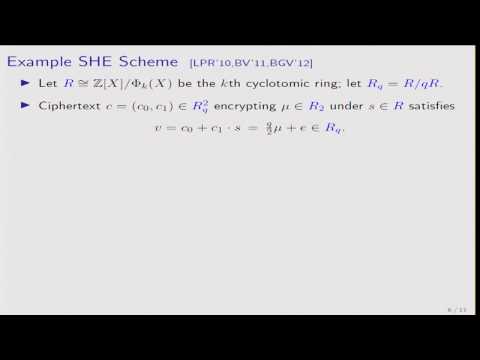Welcome to the resource topic for 2013/372
Title:
Practical Bootstrapping in Quasilinear Time
Authors: Jacob Alperin-Sheriff, Chris Peikert
Abstract:Gentry’s bootstrapping'' technique (STOC 2009) constructs a fully homomorphic encryption (FHE) scheme from a somewhat homomorphic’’ one that is powerful enough to evaluate its own decryption function. To date, it remains the only known way of obtaining unbounded FHE. Unfortunately, bootstrapping is computationally very expensive, despite the great deal of effort that has been spent on improving its efficiency. The current state of the art, due to Gentry, Halevi, and Smart (PKC 2012), is able to bootstrap packed'' ciphertexts (which encrypt up to a linear number of bits) in time only \emph{quasilinear} $\Otil(\lambda) = \lambda \cdot \log^{O(1)} \lambda$ in the security parameter. While this performance is \emph{asymptotically} optimal up to logarithmic factors, the practical import is less clear: the procedure composes multiple layers of expensive and complex operations, to the point where it appears very difficult to implement, and its concrete runtime appears worse than those of prior methods (all of which have quadratic or larger asymptotic runtimes). In this work we give \emph{simple}, \emph{practical}, and entirely \emph{algebraic} algorithms for bootstrapping in quasilinear time, for both packed’’ and non-packed'' ciphertexts. Our methods are easy to implement (especially in the non-packed case), and we believe that they will be substantially more efficient in practice than all prior realizations of bootstrapping. One of our main techniques is a substantial enhancement of the ring-switching’’ procedure of Gentry et al.~(SCN 2012), which we extend to support switching between two rings where neither is a subring of the other. Using this procedure, we give a natural method for homomorphically evaluating a broad class of structured linear transformations, including one that lets us evaluate the decryption function efficiently.
ePrint: https://eprint.iacr.org/2013/372
Talk: https://www.youtube.com/watch?v=I65sKWzNEAg
See all topics related to this paper.
Feel free to post resources that are related to this paper below.
Example resources include: implementations, explanation materials, talks, slides, links to previous discussions on other websites.
For more information, see the rules for Resource Topics .
